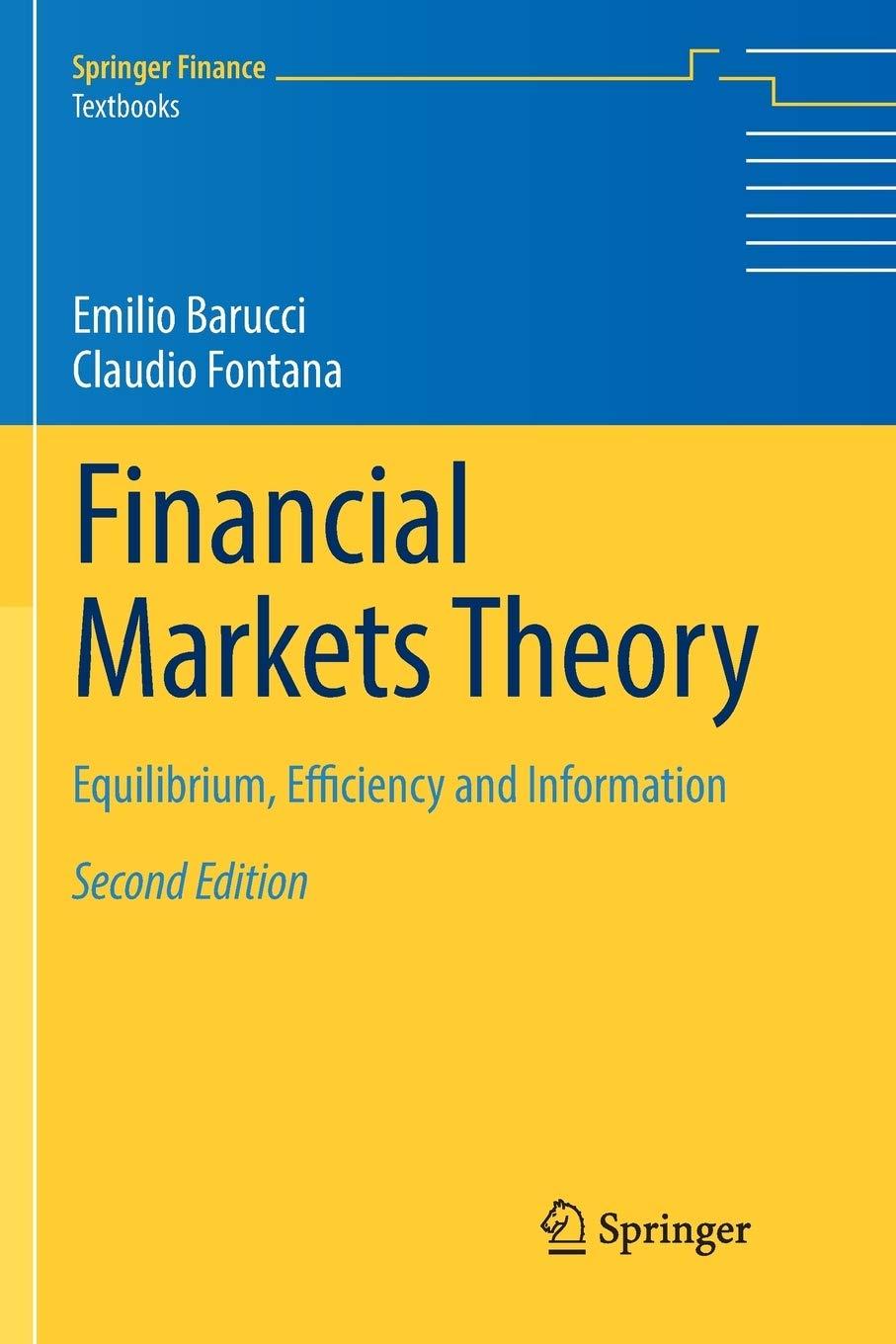Consider the model proposed in Campbell et al. [346, Section III] and discussed in Sect. 8.4. In
Question:
Consider the model proposed in Campbell et al. [346, Section III] and discussed in Sect. 8.4. In this exercise, following Campbell et al. [346, Appendix A], we compute the equilibrium price of the risky asset.
The economy is supposed to have an infinite time horizon (i.e., the trading dates are \(t \in \mathbb{N}\) ) and there are two traded assets: a riskless asset paying the constant rate of return \(r_{f}>1\) and a risky asset paying a random dividend \(d_{t}\) at each trading date \(t \in \mathbb{N}\). For each \(t \in \mathbb{N}\), the random variable \(d_{t}\) is supposed to be of the form \(d_{t}=\bar{d}+\tilde{d}_{t}\), where \(\bar{d}\) represents the average dividend and \(\mathbb{E}\left[\tilde{d}_{t}\right]=0\), for all \(t \in \mathbb{N}\).
The sequence of random variables \(\left\{\tilde{d}_{t}\right\}_{t \in \mathbb{N}}\) is assumed to follow the process \[\tilde{d}_{t}=\alpha_{d} \tilde{d}_{t-1}+\tilde{u}_{t}, \quad \text { for all } t \in \mathbb{N},\]
where \(\alpha_{d} \in[0,1]\) and \(\left(\tilde{u}_{t}\right)_{t \in \mathbb{N}}\) is a sequence of i.i.d. normally distributed random variables with zero mean and constant variance \(\sigma_{u}^{2}\). The per capita supply of the risky asset is fixed and normalized to one.
There are two classes \(A\) and \(B\) of agents. The preferences of both types of agents are represented by negative exponential utility functions, where the risk aversion parameter of class \(A\) agents is a constant \(a\), while the risk aversion parameter of class \(B\) agents is time-varying and denoted by \(b_{t}\), for \(t \in \mathbb{N}\). Let \(\lambda\) denote the proportion of type \(A\) agents in the economy.
At each trading date \(t \in \mathbb{N}\), every agent observes a signal \(\tilde{y}_{t}\), which is supposed to be of the form \[\tilde{y}_{t}=\tilde{u}_{t+1}-\tilde{\varepsilon}_{t+1}\]
where \(\left(\tilde{y}_{t}, \tilde{\varepsilon}_{t+1}\right)\) are jointly normally distributed, for all \(t \in \mathbb{N}\), with \[\mathbb{E}\left[\tilde{\varepsilon}_{t}\right]=\mathbb{E}\left[\tilde{y}_{t}\right]=0, \quad \operatorname{Var}\left(\tilde{\varepsilon}_{t}\right)=\sigma_{\varepsilon}^{2}, \quad \operatorname{Var}\left(\tilde{y}_{t}\right)=\sigma_{y}^{2} \quad \text { and } \quad \mathbb{E}\left[\tilde{u}_{t+1} \mid \tilde{y}_{t}\right]=\tilde{y}_{t} .\]
For each \(t \in \mathbb{N}\), define the following variable \(z_{t}\) that can be interpreted as the risk aversion of the marginal investor:
\[z_{t}:=\frac{a b_{t}}{(1-\lambda) a+\lambda b_{t}}\]
and assume that \(z_{t}=\bar{z}+\tilde{z}_{t}\), for all \(t \in \mathbb{N}\), where \[\tilde{z}_{t}=\alpha_{z} \tilde{z}_{t-1}+\tilde{\eta}_{t}, \quad \text { for all } t \in \mathbb{N},\]
where \(\alpha_{z} \in[0,1]\) and \(\left(\tilde{\eta}_{t}\right)_{t \in \mathbb{N}}\) is a sequence of i.i.d. normally distributed random variables with \(\mathbb{E}\left[\tilde{\eta}_{t}\right]=0\) and \(\operatorname{Var}\left(\eta_{t}\right)=\sigma_{\eta}^{2}\), for all \(t \in \mathbb{N}\), independent of all other random variables introduced so far.
Prove that the equilibrium price process \(\left(p_{t}^{*}\right)_{t \in \mathbb{N}}\) of the risky asset is given by \[\begin{equation*}
p_{t}^{*}=f_{t}-d_{t}+\left(\phi_{0}+\phi_{z} z_{t}\right) \tag{8.51}
\end{equation*}\]
where \[\phi_{0}=\frac{\left(1-\alpha_{z}\right) \phi_{z} \bar{z}}{r_{f}-1}<0 \quad \text { and } \quad \phi_{z}=-\frac{r_{f}-\alpha_{z}}{2 \sigma_{\eta}^{2}}\left(1-\sqrt{1-\left(\sigma_{\eta}^{2} / \sigma^{2, *}\right)}\right)\]
and, for all \(t \in \mathbb{N}, f_{t}\) denotes the cum-dividend fundamental value of the risky asset in the hypothetical case of risk neutral agents and is given by \[f_{t}=\sum_{s=0}^{\infty} \mathbb{E}\left[\left.\frac{\tilde{d}_{t+s}}{r_{f}^{s}} \rightvert\, \tilde{d}_{t}, \tilde{y}_{t}\right]=\frac{r_{f} \bar{d}}{r_{f}-1}+\frac{r_{f}}{r_{f}-\alpha_{d}} \tilde{d}_{t}+\frac{1}{r_{f}-\alpha_{d}} \tilde{y}_{t}\]
under the assumption that \(\sigma_{\eta}^{2} \leq \sigma^{2, *}:=\left(r_{f}-\alpha_{z}\right)^{2} /\left(4 \sigma_{f}^{2}\right)\), where \[\sigma_{f}^{2}:=\frac{r_{f}^{2}}{\left(r_{f}-\alpha_{d}\right)^{2}} \sigma_{\varepsilon}^{2}+\frac{1}{\left(r_{f}-\alpha_{d}\right)^{2}} \sigma_{\eta}^{2}\]
denotes the innovation variance of \(f_{t}\) (see Campbell et al. [346, Theorem 1]).
Step by Step Answer:

Financial Markets Theory Equilibrium Efficiency And Information
ISBN: 9781447174042
2nd Edition
Authors: Emilio Barucci, Claudio Fontana





